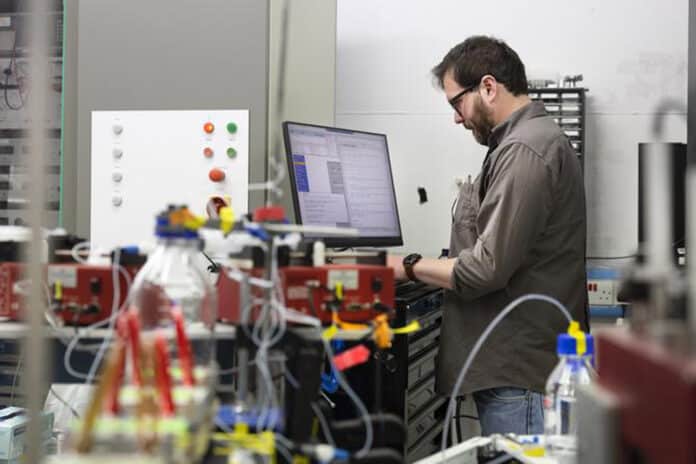Apoptosis is an essential process tightly regulated by the Bcl-2 protein family, where proapoptotic Bax triggers cell death by perforating the mitochondrial outer membrane. Although intensively studied, the molecular mechanism by which these proteins create apoptotic pores remains elusive.
Disruption of this process can cause cancerous cells to grow and not respond to cancer treatment.
A new study by Dr. Luke Clifton at the STFC ISIS Neutron and Muon Source (ISIS) in Oxfordshire, alongside co-lead Professor Gerhard Gröbner at the University of Umeå and partners at the European Spallation Source in Sweden, characterized a unique molecular mechanism of the early stages of programmed cell death or apoptosis. This process plays a crucial role in the prevention of cancer.
The discovery contributes to the team’s earlier research on the molecular mechanism of membrane-bound Bcl-2 and aids in understanding the early stages of apoptosis.
The soluble Bax protein is in charge of eliminating damaged or old cells, and when it is activated, it creates pores in the mitochondrial membrane of the cell that cause programmed cell death. Bcl-2, anchored within the mitochondrial membrane and prevents premature cell death by trapping and sequestering Bax proteins, can counteract this.
The survival protein Bcl-2 is overproduced in malignant cells, which promotes unchecked cell growth. Although the significance of this mechanism in the emergence of cancer has long been recognized, the specific function of Bax and the mitochondrial membrane in apoptosis has remained unknown.
Dr. Luke Clifton, STFC ISIS Neutron and Muon Source scientist and co-lead author, explains: “This work has advanced our knowledge of fundamental mammalian cell processes and opened exciting possibilities for future research. Understanding what things look like when cells work properly is an important step to understanding what goes wrong in cancerous cells, and so this could open doors to possible treatments.”
The scientists employed a method known as neutron reflectometry to examine how Bax interacts with the lipids in the mitochondrial membrane using the cutting-edge ISIS Surf and Offspec devices. This expanded on their earlier research on membrane-bound Bcl2.
They could observe in real-time how the protein interacts with the lipids found in the mitochondrial membrane during the early stages of apoptosis using neutron reflectometry on SURF and OFFSPEC. They discovered for the first time using deuterium-isotope tagging that Bax absorbs lipids from the mitochondrial membrane to form lipid-Bax clusters on the mitochondrial surface when it forms pores.
They determined that this pore generation had a place in two stages by combining surface infrared spectroscopy with time-resolved neutron reflectometry in the ISIS biolab. Bax was first quickly adsorbed onto the mitochondrial membrane surface, then slower membrane-destructive holes and Bax-lipid clusters formed simultaneously. On timelines of several hours, this delayed perforation process took place, akin to in vivo cell death.
For the first time, researchers have direct proof that mitochondrial lipids contribute to cell death brought on by Bax proteins during membrane perturbation.
Dr. Luke Clifton continues: “As far as we can tell, this mechanism by which Bax initiates cell death is previously unseen. Once we know more about the interplay between Bax and Bcl-2 and how it relates to this mechanism, we’ll have a complete picture of a process fundamental to human life. This work shows the capabilities of neutron reflectometry in structural studies on membrane biochemistry.”
Professor Gerhard Gröbner, University of Umeå scientist and co-lead author, says: “The unique findings here will not only have a significant impact in the field of apoptosis research but will also open gateways for exploring Bax and its relatives as interesting targets in cancer therapy such as by tuning up their cell-killing potential.”
Journal Reference:
- Luke Clifton, Hanna Wacklin-Knecht, Jorgen Aden, et al. Creating distinctive Bax-lipid complexes at mitochondrial membrane surfaces drives pore formation to initiate apoptosis. Science Advances. DOI: 10.1126/sciadv.adg7940
